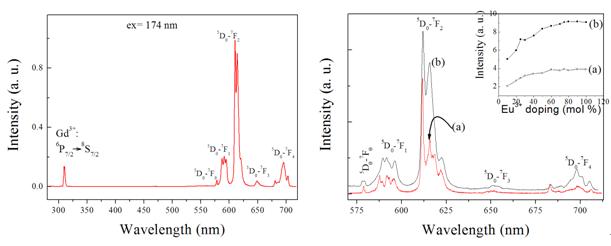| Luminescence and microstructures of Eu3+-doped Ca9LiGd2/3(PO4)7 |
| From: PublishDate:2012-06-25 Hits: |
In the RE doped compounds with a b-Ca3(PO4)2 structure, the crystallographic site-occupancy of RE in host lattices has a strong influence on the luminescence mechanism and applications, but there is nearly no report . The nature of a monovalent ion plays a critical role in the luminescence properties . The composition change from Ca9Gd(PO4)7 to Ca9MGd2/3(PO4)7 is accompanied by an increase of the luminescence intensity of Gd3+ by about 5 times for M = Na+ and a decrease of the luminescence intensity by about 4 times for M= Li+ . Among these kinds of phosphates, the luminescence spectra of Eu3+ ions (under a laser excitation λex =337.1 nm, T = 290K) have been briefly reported by Lazoryak et al.only in Eu3+-concentrated Ca9MEu2/3(PO4)7 (M = Li+ and Na+) . A team from College of Chemistry, Chemical Engineering and Materials Science of Soochow University study the red-emitting phosphors of Eu3+-doped Ca9LiGd2/3(PO4)7. Different from the work by Lazoryak et al., some new results were obtained in the present investigation. Their research has been published on Dalton Transactions . The team identified that the excitation spectra in 7F0→5D0 transition show two broad spectra, which indicates that there are at least two kinds of Eu3+ sites in the lattices. The luminescence intensity of Ca9LiGd2/3(PO4)7:Eu3+ was greatly enhanced in comparison with that of Ca9Gd(PO4)7:Eu3+. Moreover, an efficient red-emitting phosphor could be expected because of the weak concentration quenching of Eu3+ luminescence.
Fig.1 The excitation and emission spectra of Ca9LiGd2/3(PO4)7 measured by the synchrotron radiation VUV light.
Fig.2 The excitation spectra for 7F0®5D0 transition of Eu3+ in Ca9LiGd2/3(PO4)7:Eu3+ 5 mol % (a) and Ca9LiEu2/3(PO4)7 (b).
Fig.3 and Fig.4 are the emission spectra of Ca9LiGd2(1-x)/3Eu2x/3(PO4)7 (x = 0.35) excited by wavelengths from the synchrotron radiation VUV and UV light respectively. The luminescence intensity of Ca9LiGd2/3(PO4)7:Eu3+ (b)was greatly enhanced in comparison with that of Ca9Gd(PO4)7:Eu3+(a). The inset shows there is no concentration quenching. The research provides the scientific community clues to understand the luminescence mechanism and applications, synchrotron sources have helped the team to unveil the crystallographic site-occupancy of RE in host lattices . And synchrotron sources have helped the team to verify the luminescence intensity of Ca9LiGd2/3(PO4)7:Eu3+ was greatly enhanced in comparison with that of Ca9Gd(PO4)7:Eu3+. Article: Fuping Du, Rui Zhu, Yanlin Huang,Ye Taob and Hyo Jin Seo.Luminescence and microstructures of Eu3+-doped Ca9LiGd2/3(PO4)7. Dalton T., 2011, 40,11433-11440. |
|
|
| Chinese
Science Highlights
Home /
Copyright © 2011 - 2012 Beijing Synchrotron Radiation Facility




